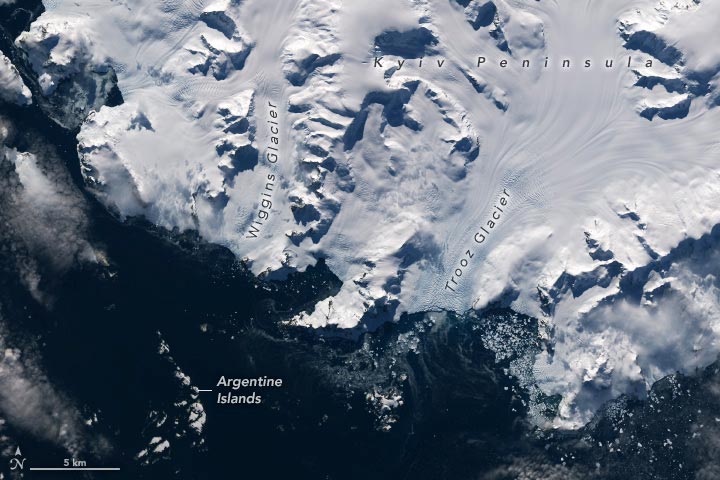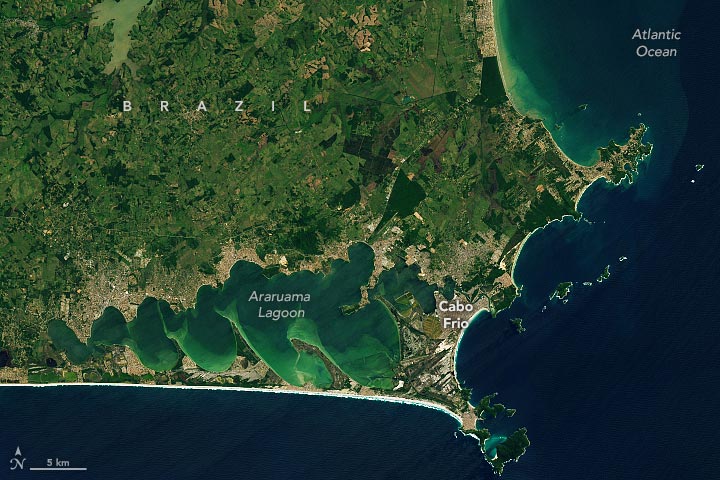Category: Earth
-

The Eternal Winter Island in Antarctica
Satellite image of Antarctica’s Argentine Islands captured on February 16, 2023, by the Operational Land Imager-2 on Landsat 9. The Antarctic island served as a winter base for early 20th-century polar explorers. Topped year-round with a layer of ice, Antarctica’s Argentine Islands display a winter-like appearance even in summer. Ice caps are visible across half of…
-

Unraveling the Secrets of Cabo Frio’s Cool Waters
Satellite image of Cabo Frio’s diverse coastline captured on September 16, 2023, by the Operational Land Imager-2 on Landsat 9. People have long noticed that the waters around Cabo Frio are unusually cool. When European explorers first surveyed the coastline of what is now the state of Rio de Janeiro in the early 1500s, they…
-

Urgent Climate Measures Needed To Avert Ice Sheet Disaster, Researchers Warn
Research from Northumbria University reveals a critical window to prevent irreversible Antarctic ice loss. While current models show no tipping point reached yet, future scenarios suggest possible ice sheet collapse within 300-500 years, highlighting the urgency of addressing climate change. Credit: TiPACC New research from Northumbria University suggests that there is a limited time frame…
-

Scientific Exploration of Unexpected Carbon Emissions
Sediment from Canada’s Mackenzie River empties into the Beaufort Sea in milky swirls in this 2017 satellite image. Scientists are studying how river discharge drives carbon dioxide emissions in this part of the Arctic Ocean. Credit: NASA Earth Observatory image by Jesse Allen using Landsat data from USGS Runoff from one of North America’s largest…
-

Illuminating Athens, Greece: Nighttime Wonders From Space
Photograph of Athens, Greece at night, captured on September 17, 2022, by an Astronaut onboard the International Space Station. Stark contrasts between light and dark indicate the interface between urban and natural areas in the Greek capital. An astronaut aboard the International Space Station took this nighttime photograph of Athens, the capital city of Greece.…
-

The Island of the Eternal Winter
Satellite image of Ireland captured on January 19, 2023, by the Moderate Resolution Imaging Spectroradiometer on NASA’s Aqua satellite. In ancient Greek and Roman times, the lush emerald isle of Ireland was called out for its long frosty seasons. The term Hibernophile may conjure an image of someone who enjoys settling in for a long…
-

Global warming intensifies typhoon-induced extreme precipitation over East Asia
Simulation outcomes from climate models for four potent typhoons (Sanba, Chaba, Maysak, and Haishen) that recently hit the Korean Peninsula under two conditions: current climate condition including all anthropogenic and natural factors (ALL) and counterfactual condition devoid of anthropogenic warming effects (NAT). Credit: POSTECH Last year, Typhoon Hinnamnor, which caused 36 fatalities, gained notoriety as…
-

Permian marine mass extinction linked to volcanism-induced anoxia
Schematic diagram of a three-stage model for the paleoenvironmental evolution of the Upper Yangtze, China, through the middle-late Permian. Credit: Wang et al 2024 Mass extinctions are rapid global decreases in Earth’s biodiversity, with five key events identified over the planet’s history, arguably the most famous of which occurred ~66 million years ago during the…
-

The Tale of Frosty, Alaska’s Dormant Stratovolcano
Satellite image of Frosty Peak Volcano captured on April 22, 2023, by the Operational Land Imager-2 on Landsat 9. The Alaskan stratovolcano has not come to life in thousands of years. Frosty is a stratovolcano located in Alaska’s Aleutian Island chain. Although the volcano has been dormant for thousands of years, the rock below its…
-

Researchers shed new light on how fog forms in mountainous areas
In the winter of 2022, University of Utah researchers operated this weather station near Utah’s Deer Creek Reservoir in the Heber Valley where they installed a trove of meteorological instrumentation for an intensive study of fog formation. Credit: Zhaoxia Pu, University of Utah Of the world’s various weather phenomena, fog is perhaps the most mysterious,…